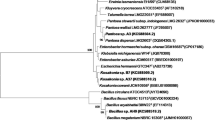Abstract
Phosphate solubilising microorganisms (PSM) (bacteria and fungi) associated with Salix alba Linn. from Lahaul and Spiti valleys of Himachal Pradesh were isolated on Pikovskaya (PVK), modified Pikovskaya (MPVK) and National Botanical Research Institute agar (NBRIP) media by spread plating. The viable colony count of P-solubilising bacteria (PSB) and fungi (PSF) was higher in rhizosphere than that of non-rhizosphere. The frequency of PSM was highest on MPVK followed by NBRIP and PVK agar. The maximum proportion of PSM out of total bacterial and fungal count was found in upper Keylong while the least in Rong Tong. The PSB frequently were Gram-positive, endosporeforming, motile rods and belonged to Bacillus sp. The PSF mainly belonged to Penicillium sp., Aspergillus fumigatus, A. niger, A. spp. and non-sporulating sterile. Amongst the isolates with high efficiency for tricalcium phosphate (TCP) solubilisation, seven bacterial and seven fungal isolates dissolved higher amount of P from North Carolina rock phosphate (NCRP) than Mussoorie rock phosphate (MRP) and Udaipur rock phosphate (URP). However, the organisms solubilised higher-P in NBRIP broth than PVK broth. SBC5 (Bacillus sp.) and SBC7 (Bacillus sp.) bacterial isolates exhibited maximun P solubilisation (40 and 33 μg ml−1 respectively) whereas FC28 (Penicillium sp.) isolate (52.3 μg ml−1) amongst fungi while solubilising URP. The amount of P solubilised was positively correlated with the decrease in pH of medium. SBC5 (Bacillus sp.), SBC7 (Bacillus sp.) and SBC4 (Micrococcus) decreased the pH of medium from 6.8 to 6.08 while FC28 (Penicillium sp.) and FC39 (Penicillium sp.) isolates of fungi recorded maximum decrease in pH of medium from 6.8 to 5.96 in NBRIP broth.
Similar content being viewed by others
References
McVicker H, Bridger GL & Nelson LB (1963) Advances in phosphate fertilizers technology and usage. Soil Science Society of America, Madison II, Wiscon, pp 155–187
Domey S, Lippmann G, Vancura V & Kunc F (1988) Stimulation of Plant growth by Phosphate Solubilizing bacteria. In-Development-in-soil science — 18 (ed.). pp 457–461
Bardiya MC & Gaur AC (1974) Isolation and screening of microorganisms dissolving low-grade rock phosphate. Folia Microbiol 19:386–389
Whitelaw MA (2000) Growth Promotion of Plants inoculated with phosphate solubilizing fungi. Advances in Agron 69:99–151
Chonker PK & Taraeder JC (1984) Accumulation of phosphates in soil. J Indian Soc Soil Sci 32:273–277
Pikovskaya RI (1948) Mobilization of phosphorus in soil in connection with vital activity of some microbial species. Microbiologiya 17:362–370
Gupta R, Singal R, Shanker A, Kuhad RC & Saxena RK (1994) A modified plate assay for screening phosphatesolubilizing microorganisms. J Gen Appl Microbiol 40:255–260
Nautiyal CS (1999) An efficient microbiological growth medium for screening phosphate solubilizing microorganisms. FEMS Microbiol Lett 170 (1):265–270
Bergy (1984) Bergey’s Manual of Systematic Bacteriology. Ed. N.R. Kreg. Williams and Wilking Baltimore, M.A., USA
Gilman JC (Ed.) (1957) A manual of soil fungi. Oxford and IBH Publishing Corporation, New Delhi, pp. 441
Watanabe FS & Olsen SR (1965) Test of an ascorbic acid method for determining phosphorus in water and Sodium bicarbonate extracts from soils. Soil Sci Soc of America Proceedings 29:677–678
Sundara B, Natarajan V & Hari K (2002) Influence of phosphorus solubilizing bacteria on changes in soil available phosphorus and sugarcane and sugar yields. Field crops Res 77:43–49
Vazquez P, Holguin G, Puente ME, Popez CA & Bashan Y (2000) Phosphate solubilizing microorganisms associated with the rhizosphere of mangroves in a semiarid coastal lagoon. Biol and Fert of Soils 30 (5–6):460–468
Gaur AC (1990) Phosphate solubilizing microorganisms as biofertilizers. Omega Scientific Farmer’s Digest 35 (5):32
Anusuya D & Jayarajan R (1998) Solubilization of phosphorus by Trichoderma viride. Curr Sci 74 (5):464–465
Goenadi DH & Siswanto SY (2000) Bioactivation of poorly soluble phosphate rocks with phosphorus solubilizing fungus. Soil Sci Soc America J 64:927–932
Author information
Authors and Affiliations
Corresponding author
Rights and permissions
About this article
Cite this article
Chatli, A.S., Beri, V. & Sidhu, B.S. Isolation and characterisation of phosphate solubilising microorganisms from the cold desert habitat of Salix alba Linn. in trans Himalayan region of Himachal Pradesh. Indian J Microbiol 48, 267–273 (2008). https://doi.org/10.1007/s12088-008-0037-y
Received:
Accepted:
Published:
Issue Date:
DOI: https://doi.org/10.1007/s12088-008-0037-y




